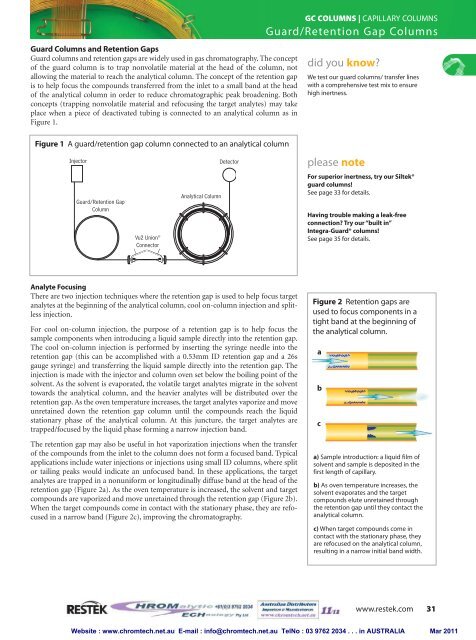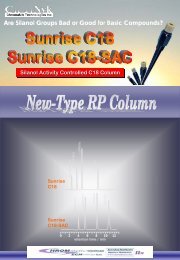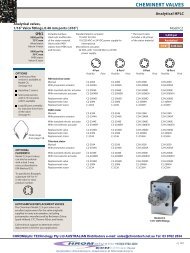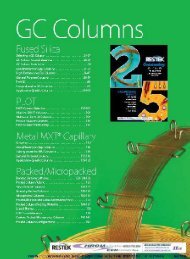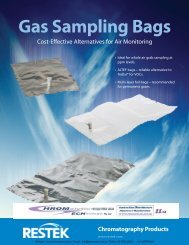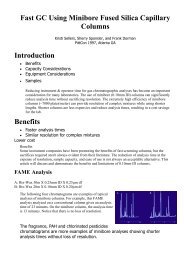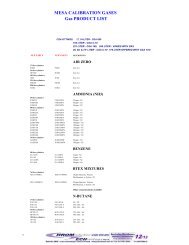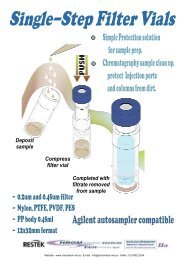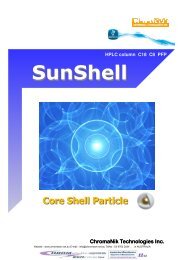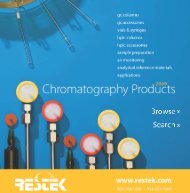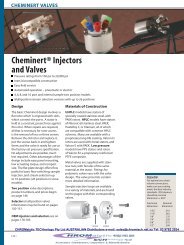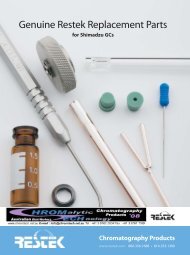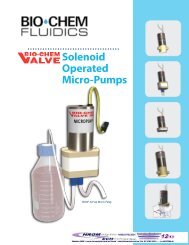You also want an ePaper? Increase the reach of your titles
YUMPU automatically turns print PDFs into web optimized ePapers that Google loves.
GC COLUMNS | CAPILLARY COLUMNS<br />
Guard/Retention Gap Columns<br />
Guard Columns and Retention Gaps<br />
Guard <strong>columns</strong> and retention gaps are widely used in gas chromatography. The concept<br />
of the guard column is to trap nonvolatile material at the head of the column, not<br />
allowing the material to reach the analytical column. The concept of the retention gap<br />
is to help focus the compounds transferred from the inlet to a small band at the head<br />
of the analytical column in order to reduce chromatographic peak broadening. Both<br />
concepts (trapping nonvolatile material and refocusing the target analytes) may take<br />
place when a piece of deactivated tubing is connected to an analytical column as in<br />
Figure 1.<br />
did you know<br />
We test our guard <strong>columns</strong>/ transfer lines<br />
with a comprehensive test mix to ensure<br />
high inertness.<br />
Figure 1 A guard/retention gap column connected to an analytical column<br />
Injector<br />
Guard/Retention Gap<br />
Column<br />
Vu2 Union ®<br />
Connector<br />
Analytical Column<br />
Detector<br />
please note<br />
For superior inertness, try our Siltek®<br />
guard <strong>columns</strong>!<br />
See page 33 for details.<br />
Having trouble making a leak-free<br />
connection Try our “built in”<br />
Integra-Guard® <strong>columns</strong>!<br />
See page 35 for details.<br />
Analyte Focusing<br />
There are two injection techniques where the retention gap is used to help focus target<br />
analytes at the beginning of the analytical column, cool on-column injection and splitless<br />
injection.<br />
For cool on-column injection, the purpose of a retention gap is to help focus the<br />
sample components when introducing a liquid sample directly into the retention gap.<br />
The cool on-column injection is performed by inserting the syringe needle into the<br />
retention gap (this can be accomplished with a 0.53mm ID retention gap and a 26s<br />
gauge syringe) and transferring the liquid sample directly into the retention gap. The<br />
injection is made with the injector and column oven set below the boiling point of the<br />
solvent. As the solvent is evaporated, the volatile target analytes migrate in the solvent<br />
towards the analytical column, and the heavier analytes will be distributed over the<br />
retention gap. As the oven temperature increases, the target analytes vaporize and move<br />
unretained down the retention gap column until the compounds reach the liquid<br />
stationary phase of the analytical column. At this juncture, the target analytes are<br />
trapped/focused by the liquid phase forming a narrow injection band.<br />
The retention gap may also be useful in hot vaporization injections when the transfer<br />
of the compounds from the inlet to the column does not form a focused band. Typical<br />
applications include water injections or injections using small ID <strong>columns</strong>, where split<br />
or tailing peaks would indicate an unfocused band. In these applications, the target<br />
analytes are trapped in a nonuniform or longitudinally diffuse band at the head of the<br />
retention gap (Figure 2a). As the oven temperature is increased, the solvent and target<br />
compounds are vaporized and move unretained through the retention gap (Figure 2b).<br />
When the target compounds come in contact with the stationary phase, they are refocused<br />
in a narrow band (Figure 2c), improving the chromatography.<br />
Figure 2 Retention gaps are<br />
used to focus components in a<br />
tight band at the beginning of<br />
the analytical column.<br />
a<br />
b<br />
c<br />
a) Sample introduction: a liquid film of<br />
solvent and sample is deposited in the<br />
first length of capillary.<br />
b) As oven temperature increases, the<br />
solvent evaporates and the target<br />
compounds elute unretained through<br />
the retention gap until they contact the<br />
analytical column.<br />
c) When target compounds come in<br />
contact with the stationary phase, they<br />
are refocused on the analytical column,<br />
resulting in a narrow initial band width.<br />
www.restek.com 31<br />
Website : www.chromtech.net.au E-mail : info@chromtech.net.au TelNo : 03 9762 2034 . . . in AUSTRALIA Mar 2011


